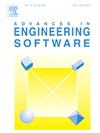Dynamic analysis of prestressed laminated stepped spherical-cylindrical shells
IF 5.7
2区 工程技术
Q2 COMPUTER SCIENCE, INTERDISCIPLINARY APPLICATIONS
引用次数: 0
Abstract
A dynamic analysis model for the laminated spherical-cylindrical shell structures under prestress is established to investigate its vibration characteristics. Based on the first-order shear deformation theory, the constitutive equations of the structural system are derived. The displacement and rotational components of the shell segments are expanded using a combination of Jacobi polynomials and Fourier series. To handle the complexities of boundary conditions and interfacial continuity between substructures, virtual spring stiffness, treated as penalty parameters, is introduced, and the dynamic characteristics of the structure are solved using the Ritz method. The reliability and accuracy of the proposed method are verified through comparisons with results from existing literature and simulations data of finite element method (FEM). Additionally, prestress is applied through continuously distributed surface loads. The study focused on examining the effects of key factors, including prestress magnitude, structural dimensions, and boundary conditions, on the free and forced vibration characteristics of the stepped shell system. This investigation aimed to elucidate the intrinsic relationship between parameter variations and dynamic responses. The computational results can provide safety guidance for the preliminary design of composite shells under prestressed conditions in engineering applications.
预应力层合阶梯球圆柱壳动力分析
建立了预应力作用下层合球圆柱壳结构的动力分析模型,研究了层合球圆柱壳结构的振动特性。基于一阶剪切变形理论,推导了结构体系的本构方程。利用雅可比多项式和傅立叶级数的组合展开了壳段的位移和转动分量。为了处理边界条件的复杂性和子结构之间的界面连续性,引入了虚拟弹簧刚度作为惩罚参数,并采用里兹法求解结构的动力特性。通过与已有文献结果和有限元模拟数据的比较,验证了所提方法的可靠性和准确性。此外,预应力是通过连续分布的表面荷载施加的。研究的重点是检查关键因素,包括预应力大小,结构尺寸和边界条件,对阶梯壳系统的自由和强制振动特性的影响。本研究旨在阐明参数变化与动力响应之间的内在关系。计算结果可为工程应用中预应力条件下复合材料壳的初步设计提供安全指导。
本文章由计算机程序翻译,如有差异,请以英文原文为准。
求助全文
约1分钟内获得全文
求助全文
来源期刊

Advances in Engineering Software
工程技术-计算机:跨学科应用
CiteScore
7.70
自引率
4.20%
发文量
169
审稿时长
37 days
期刊介绍:
The objective of this journal is to communicate recent and projected advances in computer-based engineering techniques. The fields covered include mechanical, aerospace, civil and environmental engineering, with an emphasis on research and development leading to practical problem-solving.
The scope of the journal includes:
• Innovative computational strategies and numerical algorithms for large-scale engineering problems
• Analysis and simulation techniques and systems
• Model and mesh generation
• Control of the accuracy, stability and efficiency of computational process
• Exploitation of new computing environments (eg distributed hetergeneous and collaborative computing)
• Advanced visualization techniques, virtual environments and prototyping
• Applications of AI, knowledge-based systems, computational intelligence, including fuzzy logic, neural networks and evolutionary computations
• Application of object-oriented technology to engineering problems
• Intelligent human computer interfaces
• Design automation, multidisciplinary design and optimization
• CAD, CAE and integrated process and product development systems
• Quality and reliability.
 求助内容:
求助内容: 应助结果提醒方式:
应助结果提醒方式:


